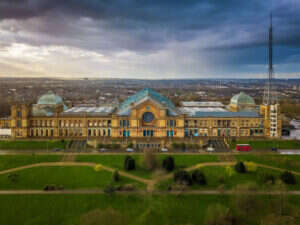The city of Utrecht might be compact but it’s a bustling centre of student life, cycling obsessives and innovative social design. With social care in the UK in something of a crisis, perhaps this small Dutch city can offer an alternative view on how young and old can reconnect and provide each other with a better quality of life.
Earlier this year, student accommodation in the city centre reached a saturation point, with a growing number of students and early careerists finding it hard to rent in the city. So, it came as a surprise when The Sofia, an elderly care home, stepped in with a solution. It owners began to offer space in its empty spare wing out as student accommodation. The only catch? The new residents had to integrate with the elderly folk who already lived there.
Around the same time, artists and NGO workers Linda Rosink and Barbara van Beers were looking for office space for their project, Artshake. They approached The Sofia and immediately realised that they could make a difference by setting up an artist residency that would organise activities and help people meet one another.
It might sound simple, but art can be intimidating. The first residency, with Italian artist Mattias Campo Dall’Orto was an experiment. Luckily, his mix of photo-realistic portraits and a huge mural painted on the side of the building helped ease up those people who felt they were “not arty”. He also paved the way for some more abstract work from French artist Caroline Derveaux-Berté.
This distinctly European flavour is a deliberate choice. The artists can’t speak Dutch and communicating with the elderly residents about upcoming events and art projects can prove tricky. However, this communication gap also gently forces the students to help with translation and spreading information. In this simple way, the elderly and young people begin to speak on common ground.
By inserting the artist as an uncertain element between the two generations, Artshake provides a talking point for the residents, asking them to get excited – or even critical – about the art together. Beyond this, the building is becoming a social hub for the neighbourhood in general. During my stay, I saw a full-blown orchestra rehearsing with the residents, and Barbara and Linda are keen to implement more art workshops, yoga, and choirs into the space.
At the most recent art residency, Caroline Derveaux-Berté‘s work on childhood memories was channeled through abstract stories. On one morning, we spent time with 66-year-old Marianne, painting walls and listening to disco. Once we had finished a couple of panels, we ripped the masking tape off – an act which really felt like a collaborative effort. Marianne took us to see the portrait Mattias had drawn of her on the previous residency, explaining how she found the artist’s intriguing. “It’s like we’re creating new memories as well,” says Caroline, “Sometimes you can look at the past and become sad, but actually by creating beautiful moments, in the present, you realise life doesn’t just finish at 66.”
The Sofia doesn’t feel like a typical care home. There’s an on-site hairdresser, a games room and coffee on tap by the receptionist. People are encouraged to loiter and chat. There’s a restaurant that wouldn’t look too out of place on Shoreditch High Street, with mason jar light bulbs and new geometric signs all around the buildings. With a fresh take on the care home, Artshake brings a sense of youth into the building showing how older generations can be exposed to new trends.
Now it feels like a home for everyone – but it might not have always been this way. During a transitional period over the summer, the first artist left and Linda noticed that “all the rules were gone. Some of the elderly people took advantage – sitting outside in front of the restaurant and having parties until 2am. Then you had the young people trying to sleep!” In fact, for Caroline the “older people are the young ones – always teaching me Dutch swearwords, drinking and talking through movies. The elderly seem to be getting a rebellious streak back.”
This inter-generational behaviour “swap” suggests that the social impact of a project like this isn’t always easy to measure empirically. When we tried to encourage some elderly people to help us paint, some had excuses: lunch to go to, family to see, dogs to walk. Even though that meant we were left holding our rollers, the power of choice can’t be underestimated. A lot of the original, elderly residents often felt like choices were being made for them; now, Linda notes that the power of saying ‘no I’m busy’ will “empower the elderly people, and show the younger students what it is like. Someday, we will be old. We have to ask: how would we like to live and be treated?”
As Caroline put it: “It’s about owning the walls. They are the simplest part of where you live but they can also keep you separate.” By breaking down the generational barriers, Artshake has proven that even the smallest element of choice can have a big impact on daily life. By inserting something new, engaging and interesting into elderly care we can begin to close the gaps between the generations.
Just seeing the interaction between different generations is enough for Linda: “As long as we see young and old talking to each other in the restaurant or saying ‘hi’ in the corridors, that’s all we want. It’s very simple.”
All pictures courtesy of the author.








